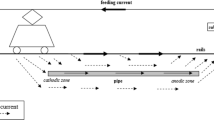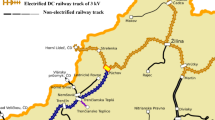Abstract
The paper presents a non-deterministic approach to the study of stray current effects generated by direct current railway or tramway lines on buried pipelines which are located in the nearby area. The potential shift induced (via conductive coupling) on the latter ones by the stray current dispersed in the soil is evaluated by means of a suitable equivalent circuit combined with a Monte Carlo procedure. The algorithm proposed has to be intended as a tool for the estimation of the corrosion risk for a pipeline (or, more in general, for long buried metallic structures) due to the stray current generated by electrified railway/tramway lines. Different from the existing models present in literature, which are based on a deterministic approach, a method based on the random and statistical aspects of stray current, which are captured by Monte Carlo approach, is proposed. This is the novelty of the method.












Similar content being viewed by others
Notes
In the Figure we have considered, for simplicity, only the case of one locomotive; the flowchart can be easily generalized to the case of more than one locomotive.
\(\gamma _{{t}}\) is the propagation constant of the track-earth circuit.
For brevity reasons, we do not consider pipe position B because the potential shift is practically 0 everywhere while the case of position C is symmetrical with respect to the case of position A.
References
von Baeckmann W, Schwenk W, Prinz W (1997) Handbook of cathodic protection, 3rd edn. Gulf Professional Publishing, Houston
Peabody AW (2001) Peabody’s control of pipeline corrosion, 2nd edn. NACE International, Houston
European Standard EN 50162 (2004) Protection against corrosion by stray current from direct current systems
Ogunsola A, Mariscotti A, Sandrolini L (2012) Estimation of stray current from a DC-electrified railway and impressed potential on a buried pipe. IEEE Trans Power Deliv 27(4):2238–2246
Machczynski W (1994) Conductive interference of electric railways on circuits with earth return. In: Proceedings of EUROEM 94, vol I, Bordeaux (France), May 30–June 3, pp 753–759
Smulders HWM, Janssen MFP (2006) Modeling d.c. stray currents using a multi-layer model. In: Proceeding of 7th World Congress on railway research, June 4–8, Montreal, Canada
Lucca G, Moro M (2004) Conductive coupling among electrified traction lines and buried structures. In: Proceedings of EMC Europe 2004, Eindhoven, The Netherlands, Sept 6–10
Ardizzon L, Pinato P, Zaninelli D (2003) Electric traction and electrolytic: a software tool for stray currents calculation. IEEE PES Transm Distrib Conf Exhib 2:550–555
Sobol M (1984) The Monte Carlo method, 2nd edn. MIR Publishers, Moscow
Hill RJ, Brillante S, Leonard PJ (2000) Railway track transmission line parameters from finite element field modelling: shunt admittance. IEE Proc Electr Power Appl 147(3):227–238
Mariscotti A, Pozzobon P (2004) Determination of the electrical parameters of railway traction lines: calculation, measurement, and reference data. IEEE Trans Power Deliv 19(4):1538–1546
ITU-T (1989) Directives concerning the protection of telecommunication lines against harmful effects from electric power and electrified railway lines, vol III. In: Capacitive, inductive and conductive coupling: physical theory and calculation methods. ITU Geneva, Switzerland
Paul CR (1994) Analysis of multiconductor transmission lines. John Wiley & Sons, New York
Seedher HR, Arora JK, Thapar B (1987) Finite expression for computation of potential in two layer soil. IEEE Trans Power Deliv PWRD–2(4):1098–1102
CIGRE (1995) Guide on the influence of high voltage A.C. power systems on metallic pipelines. Cigré WG 36.02, Cigré Technical Brochure No. 95
Author information
Authors and Affiliations
Corresponding author
Appendix
Appendix
In case of a single track line, it is possible to use a simplified analytical method to calculate current and potential along the track itself.
Let us assume the following hypotheses:
-
the track is very long so that it can be considered of infinite length (in practice, the following condition must be fulfilled for the length \(L\) of the line: \(\gamma _{{t}}{L}\ge 2\))
-
the rails are metallically connected between them along the traction line route so that they can be modelled as a single conductor with earth return.
-
only one locomotive is present in the traction line section under study
According to [5] and by considering the shunt current energisation of the track-earth circuit (see Fig. 13 relevant to the simplest case of one locomotive fed by one substation; positive sign for current injected into the track and negative sign for current flowing out from the track) we have the following results that can be obtained by means of the superposition principle of the sources:
1.1 Case A: section fed by one substation
where \(I(S)\), \(V(S)\) and \(I_{l}(S)\) are the track current, the track potential and the track leakage current to soil versus abscissa \(S\), respectively; moreover, \(r_{t}\), \(g_{t}\) and \(\gamma _{t}\) are the p.u.l. resistance, p.u.l. conductance and propagation constant of the track-earth circuit while \(J\) is the current absorbed by the locomotive which is equal and opposite to the one supplied by the substation.
1.2 Case B: section fed by two substations at the same voltage
In this case, it is possible to show that the following relations exist between the currents \(J_{1}\) and \(J_{2}\) supplied by substations 1 and 2, respectively, and the current \(J_\mathrm{loc}\) absorbed by the locomotive:
By solving system (17), we obtain:
Thus, from (18) and (19), we can deduce the formulas relevant to the track current, track potential and track leakage current:
Rights and permissions
About this article
Cite this article
Lucca, G. Estimating stray current interference from DC traction lines on buried pipelines by means of a Monte Carlo algorithm. Electr Eng 97, 277–286 (2015). https://doi.org/10.1007/s00202-015-0333-6
Received:
Accepted:
Published:
Issue Date:
DOI: https://doi.org/10.1007/s00202-015-0333-6





